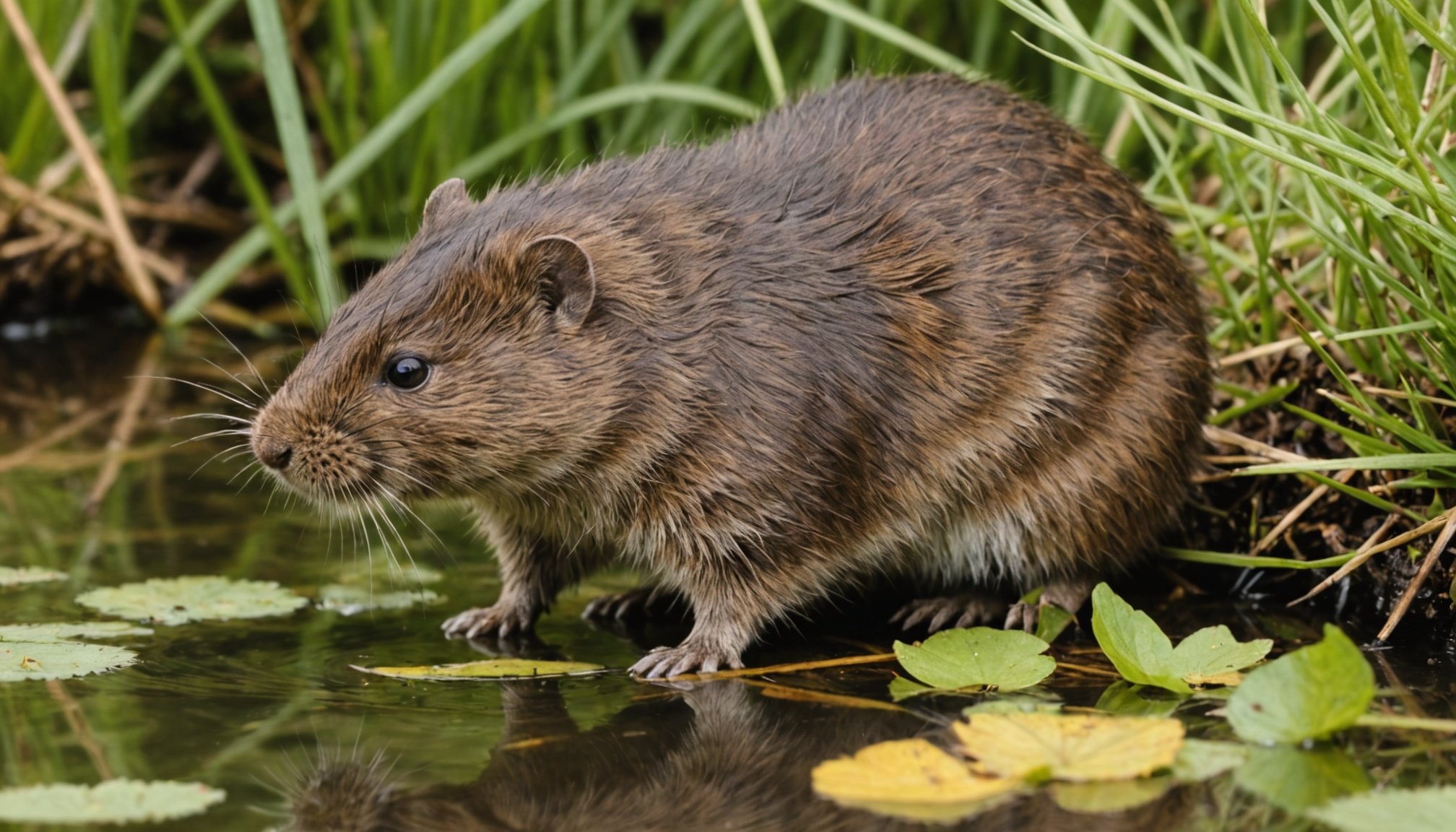Overview of Water Vole Population Challenges
Understanding the challenges faced by water voles is crucial to their conservation. This species has been experiencing significant decline, largely due to habitat loss and species decline. Water vole populations in the UK have dropped sharply over the past decades. This decline is primarily due to the deterioration of natural habitats, exacerbated by human development and agricultural expansion.
Loss of habitat is a critical issue, resulting from activities that alter wetlands and riverbanks. While urbanisation spurs economic activities, it often destroys natural habitats. Additionally, pollution influences water quality, impacting voles’ well-being and survival.
Have you seen this : Connecting the wild: how uk”s wildlife corridors promote species mobility in fragmented ecosystems
The decline of species is devastating, compromising biodiversity and ecosystem health. Water voles play a vital role in the ecological balance, and their endangerment signals wider environmental issues.
Conserving water voles is a pivotal ecological responsibility. It calls for preserving not just the voles but also the biodiversity they represent. More than ever, there is a need for concerted conservation efforts to halt this decline. Emphasising water vole conservation ensures the health of ecosystems while maintaining biodiversity. Addressing these challenges involves collaborative action, strategic planning, and public awareness to restore and protect habitats.
Have you seen this : Top fish varieties for uk ponds: boost your local ecosystem with these ideal selections
Successful Restoration Projects
Water vole restoration efforts have seen remarkable achievements through a combination of strategic planning, community engagement, and scientific research. One notable example is the restoration project in Hampshire, UK, which effectively rejuvenated water vole populations. This project focused on habitat rehabilitation by re-establishing conditions conducive to vole habitation, such as revitalizing riverbanks and reducing pollution levels.
Key methodologies included the creation of protective environments that mimic natural settings, with careful attention to vegetation and water quality. Active measures were implemented to control invasive species, providing voles with a safer and more sustainable habitat. Additionally, project teams utilized conservation success stories to inspire and inform their strategies, ensuring that past lessons guided future steps.
Long-term impacts of these efforts are evident. Biodiversity in the restored areas has visibly increased, fostering a healthier ecosystem. The conservation success stories not only serve as blueprints for other regions but also highlight the potential of collaborative, science-backed approaches to conservation. By studying and replicating these initiatives, similar projects can work towards sustainable water vole populations across the UK and beyond.
Creative Habitat Management Techniques
Innovative strategies in habitat management are essential for the successful conservation of water voles. These approaches focus on the ecological restoration necessary to support a sustainable vole population.
Natural Watercourse Restoration
Restoration of natural watercourses involves revitalizing water systems to resemble their original state. This includes reshaping riverbanks to prevent soil erosion and planting native vegetation. These efforts not only stabilise the habitat but also enhance the ecosystem’s capacity to support native wildlife.
Invasive Species Control
Effective invasive species control is critical. It involves swift identification and removal of non-native species that threaten water vole habitats. Techniques include physical removal and ecological interventions that favor native species. These actions improve the quality and safety of the environment for water voles.
Habitat Connectivity Improvements
Improving habitat connectivity is vital for wildlife migration and genetic diversity. Creating corridors between fragmented habitats allows voles and other species to move freely. Such connectivity promotes a diverse population, ensuring genetic robustness and adaptability. This interconnectedness is key to long-term ecosystem stability.
By implementing these innovative conservation techniques, the chances of sustaining water vole populations improve significantly. These methods demonstrate a promising way forward in ecological restoration efforts.
Collaborations with Conservation Organizations
Conservation organizations play a pivotal role in bolstering water vole conservation efforts, primarily through creating effective conservation partnerships. These collaborations enhance funding and resources essential for successful restoration initiatives. Non-Governmental Organizations (NGOs) are instrumental in executing wide-reaching projects aimed at reversing the tide of water vole decline.
Community involvement is a cornerstone of such partnerships. By engaging local residents, these initiatives tap into invaluable grassroots support. Community-led projects have been particularly significant, fostering an environment where local knowledge and enthusiasm drive change. These projects demonstrate significant effectiveness, showcasing the synergy between localized action and broader conservation objectives.
Wildlife organizations often spearhead these efforts, facilitating coordination amongst various stakeholders. Their experience and resources provide essential infrastructure and expertise, amplifying the impact of restoration activities. Additionally, partnerships help disseminate knowledge and best practices, encouraging replication of successful methods across different regions.
Engaging with these organizations not only improves project outcomes but also promotes a culture of conservation across communities. By building robust conservation partnerships, continuous support for habitat rehabilitation and water vole population recovery can be ensured, securing biodiversity for future generations.
Practical Tips for Community Involvement
Engaging in water vole conservation starts with active community engagement. Residents can significantly impact by participating in local conservation efforts. Here are some practical tips to get started.
Volunteer Opportunities: Many organizations offer chances to volunteer in habitat restoration projects. Volunteers can help plant native vegetation, monitor water quality, and assist in riverbank stabilization initiatives. These activities not only aid in conservation but also provide enriching learning experiences.
Resources for Organizing Local Conservation Activities: Communities are encouraged to establish conservation groups to mobilize resources and organize events. Local councils and NGOs often supply educational materials and tools to help these activities succeed. Initiatives such as organized clean-ups and educational workshops can demonstrate a strong commitment to preserving local biodiversity.
Education and Awareness: Raising awareness is crucial. Community members can host talks or distribute informational leaflets to promote the significance of water vole conservation. Schools and local clubs can include conservation topics in their programs, ensuring the younger generation understands their ecological responsibilities.
By enhancing community involvement, local conservation efforts can gain momentum, fostering an environment that actively supports water vole population recovery and ecosystem health.









